SUMMARY
This is AI generated summarization, which may have errors. For context, always refer to the full article.

Part 3
Read Part 1: Propaganda war: Weaponizing the internet
Read Part 2: How Facebook algorithms impact democracy
MANILA, Philippines – Create false perceptions. This is what a network of combined real and fake accounts on social media can achieve in a matter of minutes.
Over the past several weeks, we monitored several suspicious accounts connected to various online Facebook groups.
One account alone we determined to be fake was connected (as of October 6, 2016) to about 2.9 million members of various overseas Filipino groups associated with Ferdinand “Bongbong” Marcos Jr, and other hobby groups. Another fake account was linked to over 990,000 members of groups supporting President Rodrigo Duterte, and still another was connected to an estimated 3.8 million members of various overseas Filipino organizations and buy-and-sell groups.
Imagine the impact of a single message sent from just one fake account and spread to these hundreds of thousands of Facebook accounts. Even assuming only 10% actually share a post by a fake account, the spread of wrong information can still be damaging. They can convincingly manufacture reality on social media as they wish, transforming perception to reality, and swaying opinion on the basis of perceived number and power.
In the Philippines, with a population of 100 million, there are an estimated 47 million active Facebook accounts as of 2015.
In the 2016 elections, Facebook recorded about 22 million Filipino Facebook users interacting and actively talking about, and debating over the elections with friends and their respective connections. Yet, most political campaigners belittled the ability of social media to sway voters and influence voting – some political camps said it was just all noise with little power for conversion.
Something interesting happened, however, in the last quarter of 2015, as candidates geared up for the campaign.
Nest of ‘sock puppets’
John Victorino, an investment analyst who has been working overseas for the last 7 years, and who has monitored a nest of online accounts for at least 3 months already, spotted some noticeable patterns in what he described as suspicious accounts.
He called them “sock puppets” or fake accounts. Sock puppets are used to either amplify a message, drown out a contrary or conflicting message, or even create a false sense of the popularity of an idea or cause through amplification and spread.
Some of these sock puppets, aptly named because they act according to how a puppeteer motions them, post in existing online forums on Facebook – political groups, hobbyists, buy-and-sell, and even OFW groups, Victorino observed. The infiltration is subtle, and the undiscerning could very well fall into the trap of interacting with and helping create activity within a group or discussion thread.
Victorino said some of the accounts he watched closely were created fairly recently, in the last quarter of 2015, in the lead up to the May 2016 elections. Those who were part of this nest shared common practices:
- They used profile photos of celebrities or other sexy-looking persons instead of their own
- They used cover photos like gardens and foreign sceneries that were shared among them and their supposed friends
- They had similar liked pages such as Okay Dito and Ask Philippines
- They had less than 50 friends
One of them, linked to groups whose members number over 2.8 million as of early October, is a certain “Mutya Bautista”, a supposed software analyst at ABS-CBN. She uses the profile picture of pop star Im Yoona of Girl’s Generation, a South Korean KPop group, and has ties to over 160 groups – the biggest of which is BongBong Marcos United at over 160,000 members, and other overseas Filipino workers groups like Pinoy OFW sa UAE with over 67,000 members.
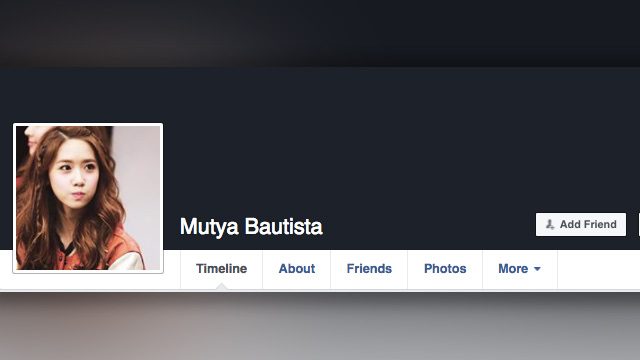
A check with ABS-CBN showed that “Mutya Bautista,” who has only 21 friends, was and is not connected with the media giant, just like several others such as “Jovelyn Mayor”, “Lenny de Jesus”, “Babylyn Ventura”, “Kim Montes”, and “Julius Marquez” who all also claimed to be with ABS-CBN.
“Lily Lopez” also declared herself to be connected with Xurpas Inc. But she’s not. She used as her profile picture the photo of former Miss Korea and now actress Kim Sa-rang. She also happens to be a Facebook “friend” of the fake “Mutya Bautista”.

Another interesting profile is that of “Luvimin Cancio”, who sourced her profile photo from softcorecams.com. This was established via tineye.com. She has 46 friends – many of them sock puppets too sharing the same characteristics, and some of them appearing to be real people.

A fourth Facebook account, that of “Jasmin De La Torre”, shows the exact same cover photo as Lily Lopez. She only has 14 friends as of October 7 but is a member of various groups whose members total almost a million.
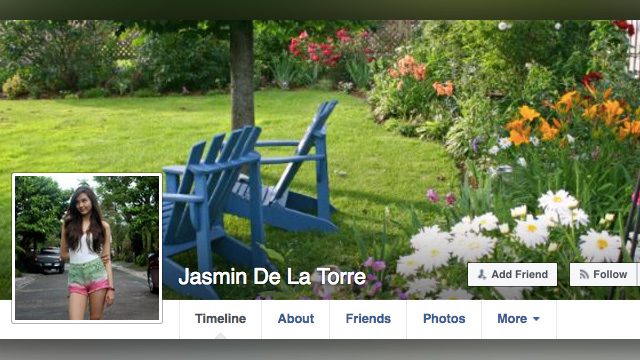
There is also the account of “Raden Alfaro Payas”, who has links to over 200 groups with over 3.8 million members. Raden uses another profile picture also of Im Yoona. He however describes himself as a senior engineer at Northrup Grumman Corporation and lives in Grand Rapids, Michigan. This account has 49 friends as of October 5, about 13 of them part of the nest of 26 sock puppets watched closely by Victorino. Among Raden’s friends is someone with an identical name but who appears to be a real person.
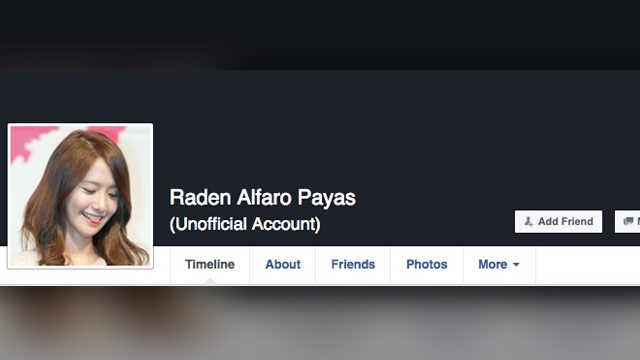
The same real person Raden has over 1,300 friends, among them at least 16 with fake accounts. He also creates a page as a public figure with likes of over 1,200 people.
How falsehood spreads
To illustrate how one misleading and false information can be spread using a mix of trolls and real people, Victorino pointed to identical posts by “Mutya Bautista” and the real person Raden Alfaro Payas shared with the groups BongBong Marcos United and Bongbong Marcos Loyalist Facebook Warriors last June:
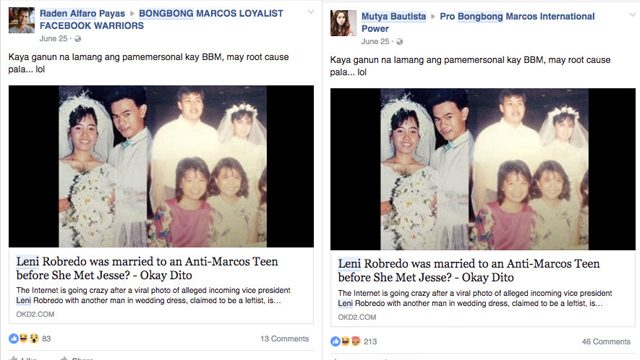
Similarly there was a post from the fake account of “Luvimin Cancio” on the Rody R. Duterte Movement group about “alleged martial law victims” posted last September 28 on a blog, why0why.com.

The blog also said: “Martial law victims should tell young generation that ‘pasaway kami kaya kami nakulong.’” (We were belligerent that’s why we were imprisoned.)
Affirmed by what appears to be another account of Raden Alfaro Payas, created only last September 21, information about victims of Martial Law is twisted and reaffirmed by another troll or fake account.
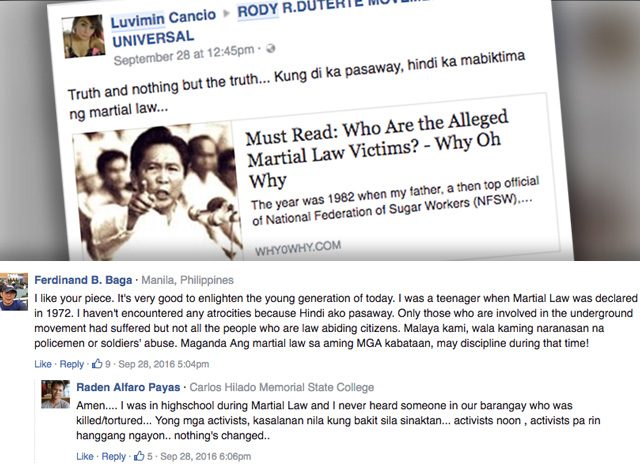
Efficient use of social media
Social media by itself can be empowering for the disadvantaged and those without access to mainstream media.
For instance, Nic Gabunada, who was part of the presidential campaign of then Davao mayor Rodrigo Duterte, said limited campaign funds forced them to be creative in using the social media space. Duterte’s campaign budget was nowhere near the budget of other presidential contenders, if political ads were any indication. In the past, presidential campaigns were said to cost anywhere between P1 billion to P3 billion.
In an interview last June with Rappler, Gabunada, who was part of the Duterte campaign communications team, said his P10-million budget allowed him to tap into a robust volunteer network of about 400-500 whose individual networks at the time of the campaign reached hundreds of thousands – the largest group having about 800,000 members.
It was these “warriors” on social media who delivered the presidency to Duterte, who won with over 16.6 million votes – convincingly and overwhelmingly over his strongest rival Manuel “Mar” Roxas II who got over 9.9 million votes.
In contrast, the battle for the vice presidency was intense and breathlessly close between Leni Robredo of the Liberal Party and Marcos. Robredo edged out Marcos, garnering 14.4 million votes compared to his 14.2 million votes.
Duterte campaign insiders admitted they used trolls or fake accounts and paid for them, along with “influencers” on social media, essentially people or accounts that had a huge following. There was no unanimity of opinion within the Duterte camp, however, as some like Duterte social media director Pompee La Viña were reported to have favored more engagement over the use of trolls.
It was Gabunada who had part command over the efficient network that included overseas Filipino workers (OFWs) and even regional groups in Luzon, Visayas, and Mindanao. During the campaign, there were messages of the week or of the month cascaded to what he called “parallel groups” or the Duterte “warriors”.
They had administrator or “admin coordinators” in various chat rooms that already existed. A chat group of admins constituted the “super admins”.
Gabunada explained that it could be a chat group of 20 people who could each be administering two to 5 chat groups or pages. “Their whole principle is organizing for social media effectiveness,” Gabunada said.
But even after an overwhelming victory with over 16 million votes, Gabunada explained there was a need to continue campaigning because they got “only 40% of the votes” and needed more than that to allow Duterte to effectively govern.
He admitted there were some groups “[na] talagang palaban, matigas ulo (really combative, hard-headed)…sometimes we felt they were out of control so mahirap ma-associate doon (it was hard to be associated with them).”
At the time, they were also suspicious of other camps doing counter propaganda. And they could be at play even today, Duterte supporters say.
Fast-forward to the present, months after Duterte won as president, there is evidence that trolls are still very much alive. These trolls “seed” messages taken from blogs and pages, and which are then amplified by other trolls and spread through members of bigger groups. The messages are beneficial to various political camps and interests, creating a false notion of what is true and what is real.
Propaganda agents and propagators
In addition to the activities of the trolls, there are also noticeable “propaganda pages” associated with Duterte.
In September of this year, du30newsinfo.com was observed to have at least 13 agents or spammers who posted over 4,000 posts in more than 40 groups. An account is classified as an agent or spammer if it had posted more than 100 items in groups in a single month from a single website or page alone. The 4,000 posts resulted in a cumulative 170,000-plus shares. This means that one post alone generated an average of over 40 shares. At least five of these posts received more than 1,000 shares. This is how one post can go viral very quickly.
Besides that, newsph.info, with only 5 agents generated over 50,000 shares from only 1,300 posts during the same period. Similarly, nowreader.com generated 39,000 shares from over 1,100 posts of only 3 agents.
In the same month, the site whose content is regularly shared by the troll Luvimin Cancio, OKD2.com, got 11,900 shares from only 716 posts.
From August 1 to September 20, some accounts were observed to be sharing the same links more than 7 times on average with different groups. Our tally showed that each of the top 10 “spammers” who mentioned Senator Leila de Lima, a recent favorite, posted at least 200 messages during that period.
Interestingly, on October 5, one account was observed to be sharing a link about alleged drug lord Jaybee Sebastian to 23 different groups in rapid succession, merely copy-pasting text for each post. The interval of posts varied from 3 seconds to 6 minutes based on time stamps.
The frequency of posts of sock puppets and real persons alike indicate any of several things:
- posters who pretty much post and share content to their liking throughout the day are dedicated followers or supporters of whoever they are supporting
- posts are automated
- posts can be misused as an effective tool of harassment
- posters copy-paste and share content for a living
‘Business partners’
How much are trolls paid – whether for political or commercial purposes?
In one page for commercial purposes, for example, repeated call-outs were made for “business partners” who were required in 2015 to spend 3-5 hours daily on Facebook. Payment was supposed to range conservatively from P1,000 a day to P10,000 a month, with training provided.
The Inquirer had reported that some trolls even get paid from P2,000 to P3,000 a day just by copy-pasting content. This explains the uniform posts or comments seen on Facebook. Clearly, trolling has become and can become an even more lucrative business.
The danger of propagators spreading false or misleading information is all too evident. It can result in beliefs or convictions anchored on false premises. Different versions of what is supposed to be the one true fact can be manufactured, creating confusion and deep-seated schisms among groups who get to believe that their version of the truth is what is real and correct.
Expose the fake, don’t engage
What to do, given a virtual world of manufactured truth and reality?
- Spot and actively call out the fake accounts, the sock puppets, the trolls.
- Gather evidence and report them.
- Don’t bother to engage them because it is a lost cause.
- Help clean up the social media space and restore it to what it used to be, or at least a semblance of what it used to be.
Abandoning social media and not challenging lies being peddled and spread is losing by default to the trolls and propagandists.
In August this year, Archbishop Socrates Villegas spoke to a group of youth leaders and priests during a clergy recollection on how priests should respond to the current socioeconomic landscape. He told them about the boiling frog syndrome. Easy to find on Google, the anecdote about how a frog can slowly be boiled alive without it realizing what’s happening was shared by Villegas.
If it’s thrown into a pot of boiling water, a frog would jump out. But if it’s put in cold or lukewarm water which is slowly put to a boil, the frog will not sense the danger until it is cooked to death. The frog takes in the water and frolics in it before it realizes too late that because the water has already become too hot, it’s already impossible to get out.
The parallelisms of the boiling frog syndrome with the lies being propagated, tolerated, and accepted are easy to see. Without doing anything, users of social media may find themselves no different from the desensitized frog slowly cooked in the heat and the fire.
The battle to preserve truth has shifted online and is no longer fought in the streets alone. Technology has created platforms of empowerment and self-expression, but without timely intervention, it could evolve into a monster that could devour and swallow us all. – with John Victorino and Wayne Manuel/Rappler.com
Add a comment
How does this make you feel?
There are no comments yet. Add your comment to start the conversation.